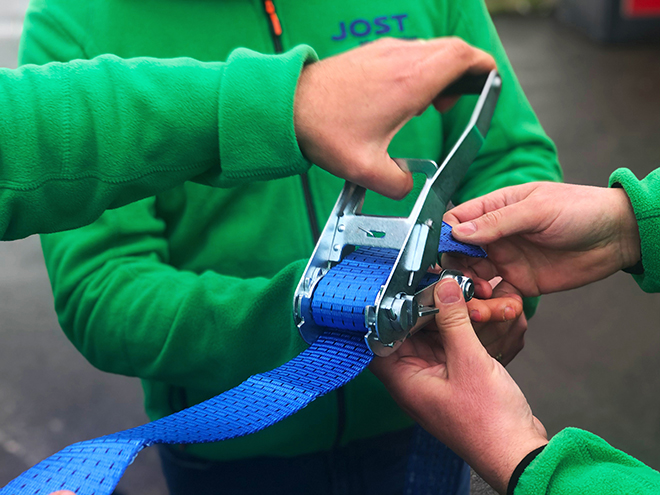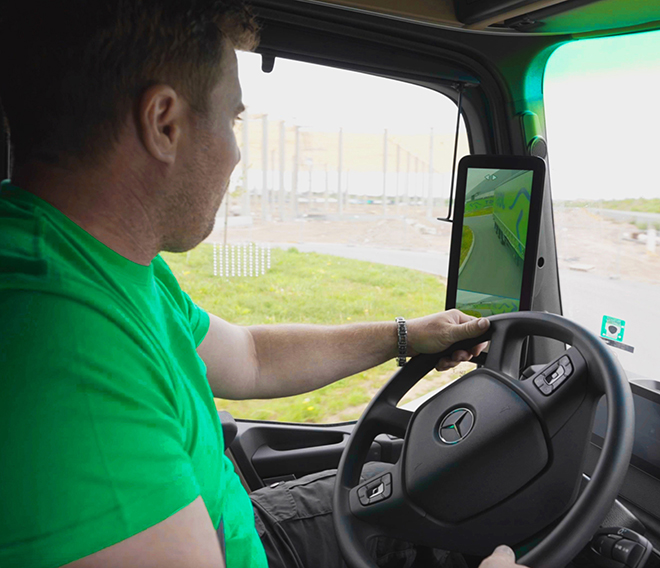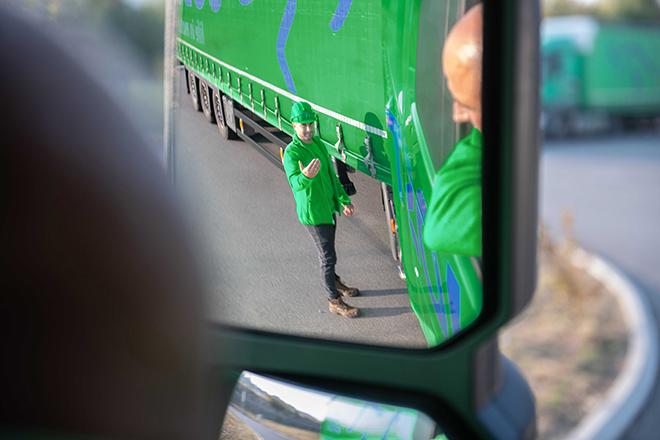JOST attaches great importance to the safety of its employees and drivers, as well as to that of its partners, and to preventing any risks to other road users.
Our goal is to do everything to prevent accidents happening. Risk assessments, constantly adapted to new and changing situations, as well as the opinions of our prevention advisers, dictate the behaviour of each of our employees.
Safety/quality assurance/environmental departments, trainers, in-house auditors, planning/logistics/facility management/technical and communication departments: all are mobilised to raise staff awareness to the right behaviour in terms of safety.


A vehicle fleet monitored and equipped beyond industry standards
Our trucks are fitted with "safety" options going beyond the required industry standards!
They are equipped with emergency braking and blind-spot detection systems. A pilot project involving 360-degree cameras is currently being tested, so that nothing and no one remains invisible to our drivers.
Our trucks are fitted with lane departure warning systems. Connected to the camera placed on the windscreen, this system also enables a vehicle to be automatically stopped in the event of a risk of a frontal collision without the driver reacting.
These optional extras have the goal of preventing all road accidents – for the safety of all road users.
Vehicles are systematically inspected in our various maintenance centres.
We monitor in real time the technical state of our vehicles via software allowing us to constantly monitor them, even remotely, and to immediately order interventions in the event of a potential problem.
Vehicle maintenance is performed preventively, at defined intervals taking account of the different uses of the vehicles. In the same vein, we monitor vehicles with refrigeration units, checking that everything is working properly in real time.
Periodic controls of our vehicles take place in our own bodywork, mechanical, tire and refrigeration unit workshops.
As a next step, we will be investing in a system of on-board cameras allowing us to monitor driving behaviour with a view to coaching our drivers on habits needing to be adjusted, either remotely in their trucks or in our training centres. Currently being tested, these cameras are greatly appreciated by our drivers who see them as an opportunity to further boost their professionalism. The results obtained have been a real turning point in our approach to complementing the permanent training of our staff underway throughout Europe.
Continuous state-of-the-art training
Drivers trained from A to Z!
JOST takes pride in training its frontline ambassadors as best as possible.
On starting work at JOST, following an aptitude test on private and public roads, drivers are given initial training covering all the key factors making out a professional driver. From a vehicle’s driveability, via its optimal technical operation, to the use of its equipment and the specific procedures of the customers that they will be serving, our candidates are taken in hand by our training centres.
Drivers are then mentored by one of more of our company’s experienced drivers, then re-assessed and, at the end of the probationary period, given the green light by a trainer.
Drivers take several training courses in eco-driving, with their driving habits subjected to scrutiny by a trainer. After coaching based on these observations, drivers again drive the same route, with results compared. Improvements include a better use of engine torque, anticipation of dangers and traffic situations and thereby less braking and re-acceleration, and the use of vehicle inertia. Permanently available, this training is triggered by the results of the analysis of a driver’s driving behaviour and his fuel consumption.
The mandatory CODE 95 training is renewed every 5 years via a 35-hour training course held in our approved centre and focused on optimising fuel consumption, defensive driving, cargo securing, a positive mentality in traffic as well as the right attitude towards other road users.
Continuing training (CVET) for drivers covers initiation into new types of vehicles and new equipment. Specific training is given for specific types of traffic, types of work and customer procedures.
Should a driver be found to not be complying with our rules, he will systematically be taken back into training with a view to achieving a permanent improvement of his driving efficiency.


Analysis, assessment, report
Our training, quality assurance and safety departments work together on establishing risk assessment methods reviewing the probability of risks materialising, exposure to them and their consequences, with results reported annually.
A skill acquisition assessment is performed by the team of Quality Improvement Coordinators and/or the auditors. Precise monthly analyses and statistics are used to constantly "tweak" our training programs. They are also adjusted to take account of developments in types of work, technical or legal developments or of day-to-day situations.
The goal here is to always be one step ahead to prevent potential accidents!
